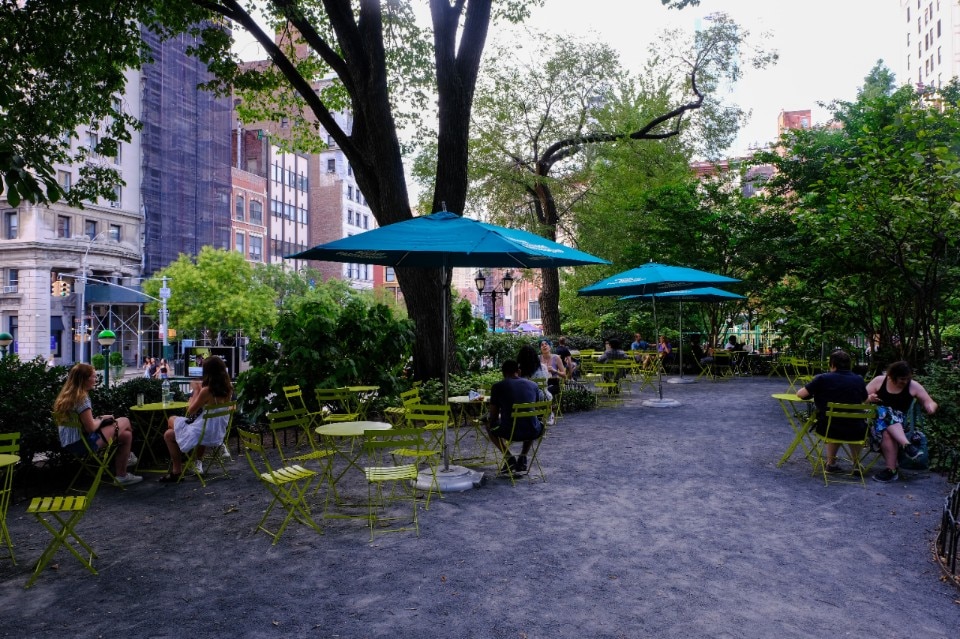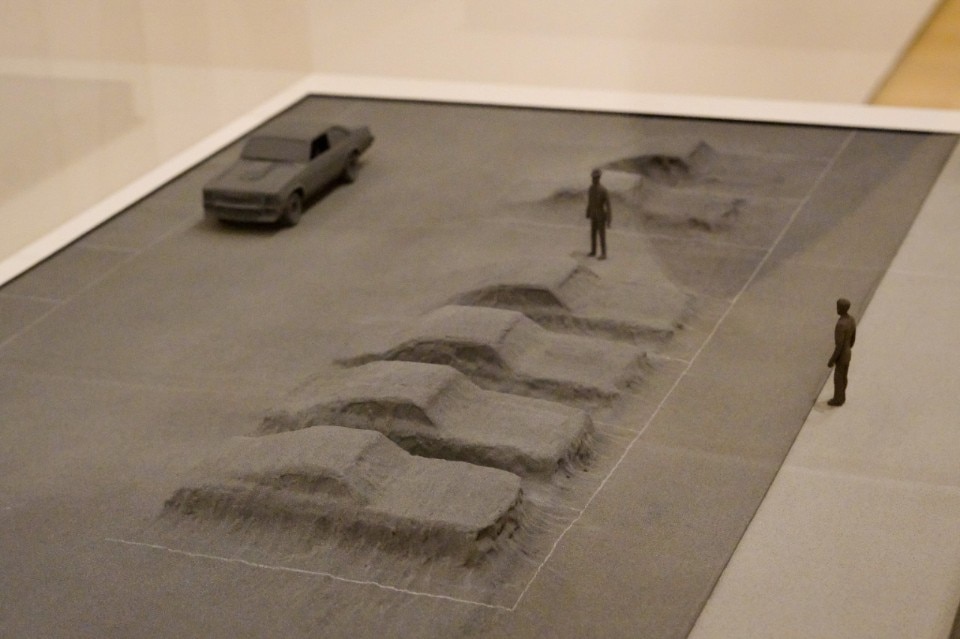I found a sign outside the coffee shop where I get my morning cold brew coffee cup and do some writing.
It says: “The city requires vaccination proof for all indoor seated customers. Please present it to us if you want to be seated inside”.
The new mandate applies to stores, fitness clubs, and movie theatres as well. Vaccines are mandatory for healthcare workers. Many colleges will request vaccinations for in-person attendance of the fall semester, with masks required for indoor activities.
According to news channel NY1, 56% of all New Yorkers are fully vaccinated.

Vaccinations on the go
Everything you do in a store, it’s something you can probably do in a van, stationed at the side of a New York road.
I’ve spotted veterinary van clinics. Moving barbershops. And lots of food trucks, obviously.
Here in New York, you can get a vaccination shot on the streets.
As well as a Covid test. Both for free.
And you don’t need to disclose your immigrant status, to do that.

Outdoor dining
“New York City is a place that welcomes everybody striving who wants to invent and discover: so you have many many people living alone, in very very small tight quarters that became even more impressive during the pandemic”, say Marion Weiss and Michael Manfredi, founders of WEISS/MANFREDI architecture studio. “So to be able to feel that the city is larger and yours, public parks are essential, as in our thinking now the claiming of the streets for the restaurants is something that we hope never goes away. It’s just basically saying that now our need to be, might be greater than our need to park a car”.

Outdoor dining was approved to help the restaurants, and yet it obviously helped the city. “So we hope that this tragedy is creating new urban paradigms that will endure in new ways”. And the answer is positive when I ask if they think that outdoor dining is going to stay. “Yes, because it’s economically very popular”, Michael Manfredi replies smiling.
Return to street-level life

It’s not just about the restaurants. If you walk through Union Square Park, billed as “Reunion” now, in tune with current times, you’ll spot garden tables and seats and parasols, where people have a snack or read or meet. That’s not a bar, it’s the New York City way to furnish the outdoors, and you’ll find it in plazas and parks.
New Yorkers are reconquering the streets: no news, here. But during pandemic times it’s something that became huge.

This is the city where people gather around an open hydrant during the summer, and the city of block parties, a tradition that goes back as far as the 1860s, and as Sandra E. Garcia wrote on the New York Times well before the pandemic began: “New Yorkers, we live on top of one another, so it’s only natural that sometimes we spill out onto the concrete”.

In Spring 2020, Mayor de Blasio signed for the Open Street program to become permanent. Through it, communities can “embrace new public spaces and support small businesses”, prioritizing pedestrians and cyclists “by transforming streets into public space”.

Two gigantic murals were created in Union Square by Brooklyn-based street artists Geraluz and Werc to celebrate the recovery from Covid-19, along two new pedestrian walkways cut off the road and taken away from car traffic.

Sustainabilty will make people come back
ODA founder Eran Chen is sure that in 10 years we’ll see a big revival of cities, in opposition with the current trend to move out. “People will love to come back because there will be a major shift”. To make that happen, cities have to become more sustainable, but not only environmentally. “Social sustainability is the ability of people and clusters of communities to live over time and flourish in a certain neighborhood. And economical sustainability is the ability for people to have their own businesses”, and even if they’re not wealthy, “to create economical growth within their communities”.
“If we create good things in the city”, he concludes, “that will create a huge flux of people back”.
The car is dead, long live the car!
“Cars have reimagined mobility, connecting us across great distances at ever greater speed, but this increased freedom and economic empowerment have come at the expense of tremendous human suffering and environmental damage,” says Juliet Kinchin, former curator at MoMa, about Automania, an exhibition “exploring 20th century car culture”. It’s the occasion to show off nine cars from the Museum’s collection, including the recently acquired Citroen DS 23 sedan and a 1965 Porsche 911 coupé.

On a Saturday afternoon, kids act excited for the cars on display, approaching them like some precious and rare relic from the past. But the real value of the exhibition are the paintings, Robert Frank and Margarite Bourke-White’s photographs, the work of Andy Warhol and Frank Lloyd Wright, and the model showing James Wines’ Ghost Parking Lot in Hamden.
Powerful images of a world where cars were central, that feel a bit awkward and old-fashioned today, since the presence of cars, and the poetry that celebrated them, have become rare even in automobile advertising.

Two interesting things guided how museums acted during the lockdown (Karen Wong)
Sunday always comes too late
Sunday morning, 8am.
I’m out of Nowadays, a venue that friend and Domus contributor Virginia Ricci suggested me to visit. “I’ve followed their Patreon account through all the pandemic, they’re doing a great job “, she explained to me.
I’m in line.
Soon, British electronic musician Four Tet is going to play inside.
In a large dimly lit room, full of plants.
And crowded with people, dancing.
Dancing indoor is something that you can do, in New York. And optimistically nobody will jump on you, or spill a drink on you, or push you, like it would happen in Milan. Distance has always been a thing while attending live music, here in America.
I’m in a line now. It’s not a long line. It’ morning.
There are three persons, at the head of the line. They check tickets, and our vaccination certificates.
“I’ve got an European Green Pass”, I say. “It’s ok, go on”, replies the slim and blonde guy.
Then we’re five or six people, gathered in a dark room, and there’s a man that explains the club rules. No staring, no touching, no harassment. Respect everybody. Otherwise you’re out.
I realize how cool it is to have someone who tells you the rules of a place, before you enter.
Then I’m in. There’s a large bar, and a huge garden outdoor.
It’s full of people.
Bass vibrations are like a siren song, to me.
Using your phone on the dancing floor is forbidden.
That’s a good idea, and so I switch off mine.

A tip from professor Reinhold Martin
“If you want to report to your readers about what’s going on in New York, a good idea would be to pull away the noise about the various architects and their styles and their personalities. And realize that what we’re looking at is a television commercial. It’s commercial architecture. And some of it is designed by very good architects and some of the buildings are pretty good. And they’re nice people who design those buildings, but it doesn’t matter if they’re nice people. They’re still designing for profit”.

New York’s vaporettos
“Are you familiar with NYC ferry?”, asks me Chris Singleton, Assistant Vice President, Public Affairs of Economic Development Corporation. This New York agency has many ongoing projects in the city, mostly about parks and green areas, and ferries are, Singleton explains, “probably” the most important transportation project that EDC oversees. “New York ferry system right now runs on the East River, on the East Side of Manhattan, and we have about six routes. It’s 2.75$ per ride, so it’s the same cost as a MetroCard swipe (single subway trip, Ed)”. Singleton explains how people can travel by water very, very quickly and efficiently throughout many different neighbourhoods on Brooklyn and Manhattan waterfront, from Governors Island to Queens up to the Bronx. Launched in 2017, the ferry project is still growing. “We’re going to expand it from Staten Island to Battery Park, continuing further up the West Side of Manhattan, and that’s the first route that goes up the Hudson River”.

Ferries offer stunning views of the city, but they can also serve New Yorkers’ more pragmatic needs. “Often people have a 15 to 25 minute walk just to get to the nearest subway station”, says Singleton, “but they’re close to the water”. Considering that in New York creating new subway lines is extremely expensive, as professor Rit Aggarwala explained to me when we met at the Cornell Tech campus, and all existing underground routes but one pass through Manhattan, developing more ferry lines looks like a promising future scenario.
The idea of water as public space is still kind of new in the city (Dong-Ping Wong, speaking about + POOL)
All photos were taken with a Fujifilm X-Pro 3, kindly loaned by Fujifilm Italy, except where otherwise indicated.


